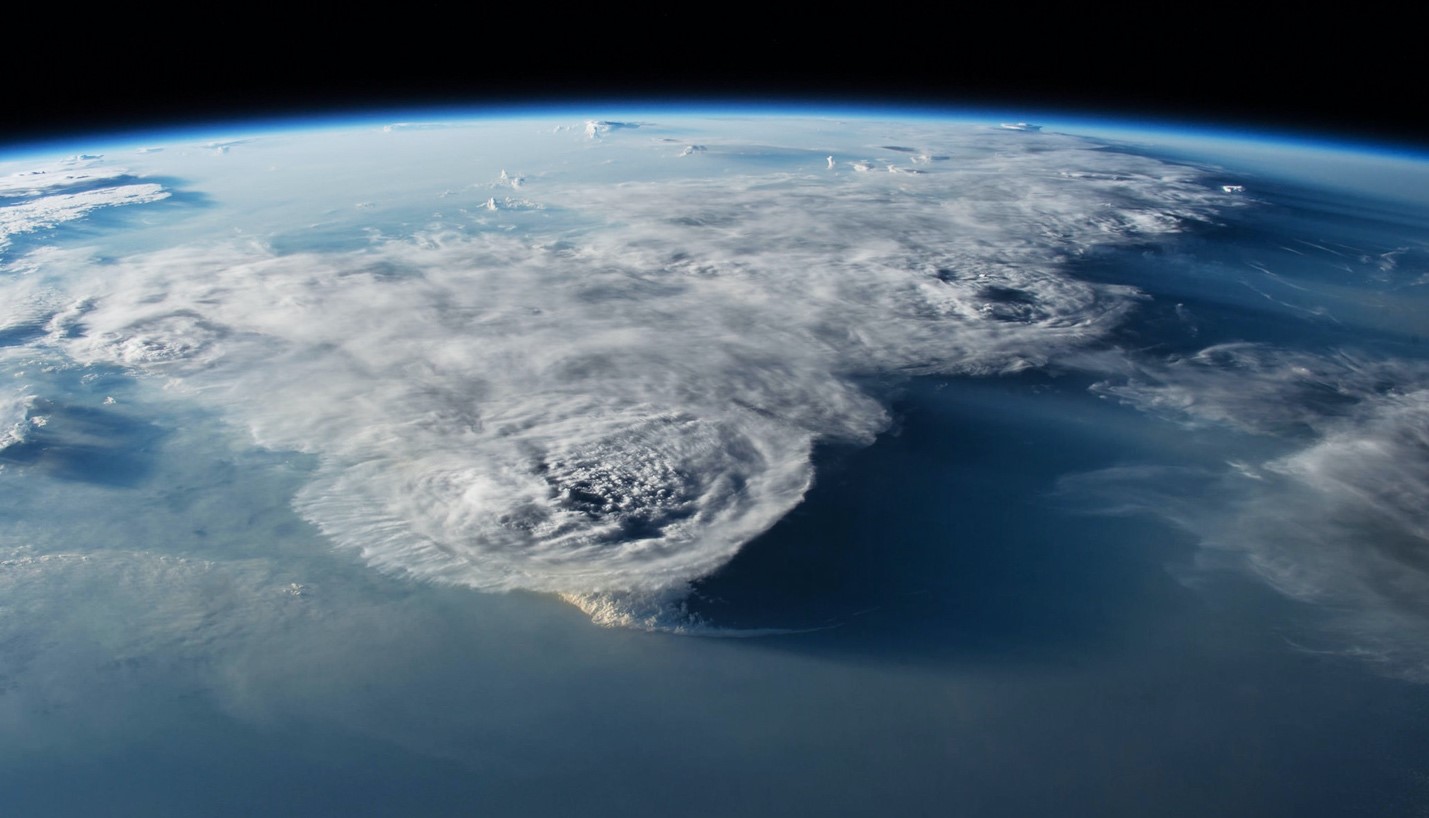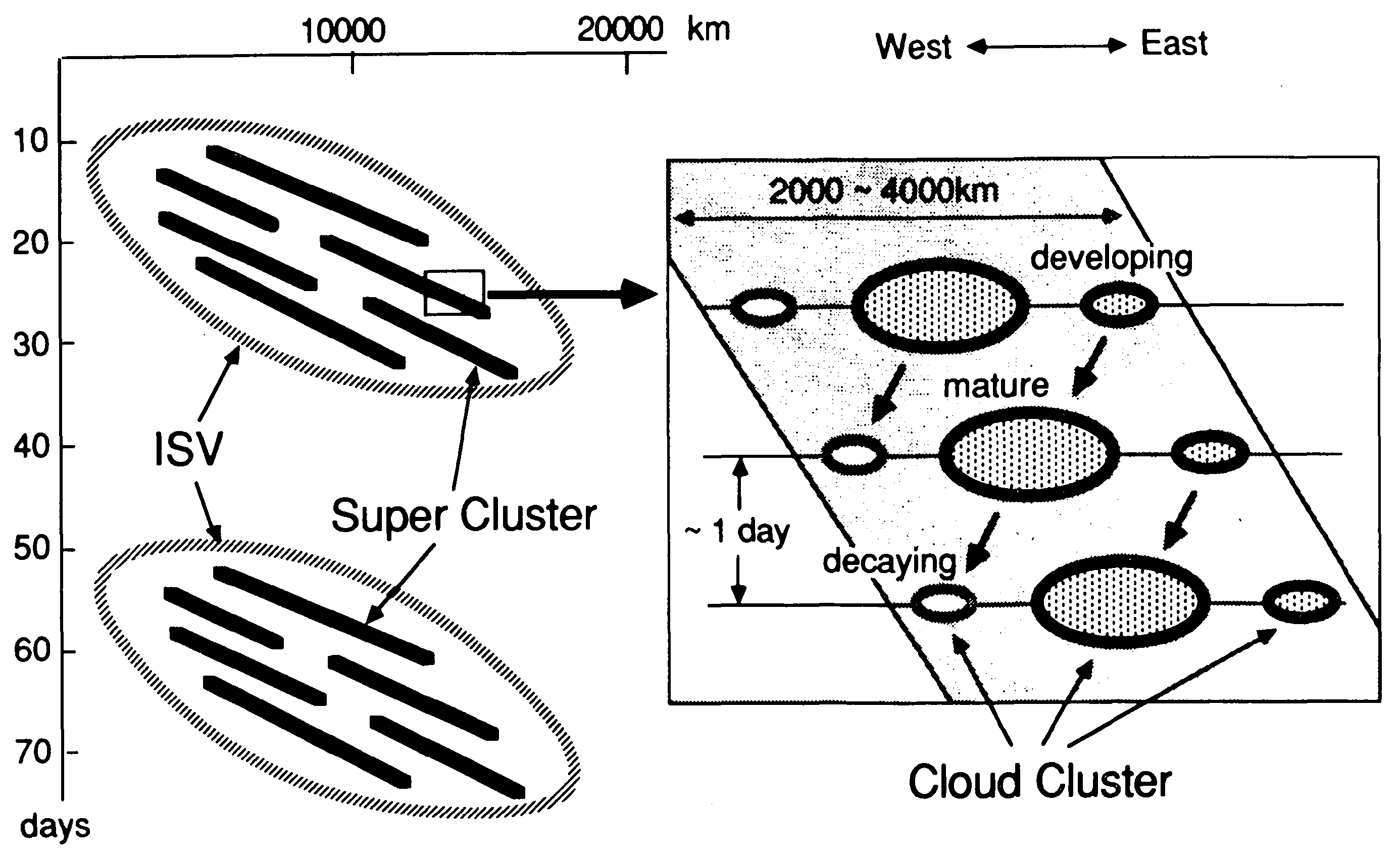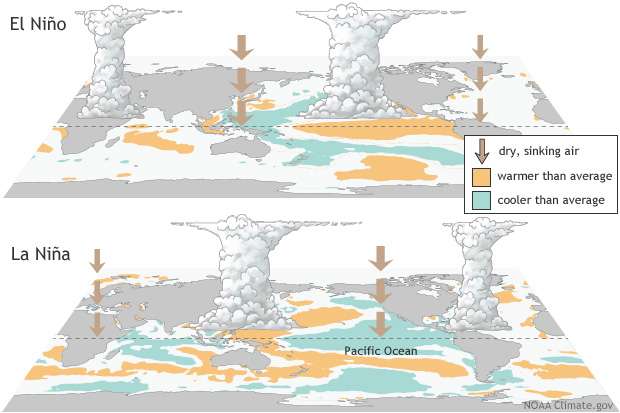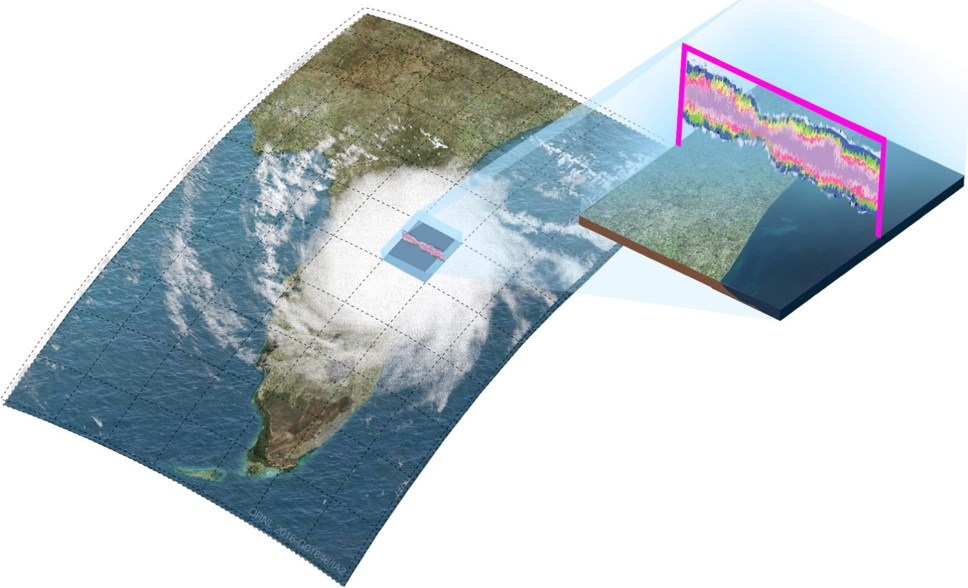I am an atmospheric dynamics scientist with a keen interest in studying large-scale organized convection such as the Madden-Julian oscillation (MJO) and mesoscale convective systems (MCSs). Compared with individual thunderstorms that only persist for a few hours, organized convection such as MCSs can last for more than a day and releases a massive amount of rainfall, inducing a vast impact on local weather and the hydrologic cycle. However, it is a huge challenge for global climate models (GCMs) to accurately simulate organized convection and the associated precipitation. My major expertise lies in developing theoretical models for organized convection, in combination with observations, numerical models, and applied math tools. The goal of my research is to obtain a better understanding of fundamental mechanisms of organized convection and provide useful guidelines for improving weather and climate models. Below I briefly describe several major research projects I have done before.
Topic 1: Initiation and development of MCSs and their changes under global warming
 Even state-of-the-art numerical simulations still present significant biases in simulating mid-latitude MCSs (the right picture is from link), particularly during the summertime when synoptic forcing is typically weak. From a theoretical perspective, a suitable model to capture the realistic properties of MCSs and isolate the bare-bone mechanisms for their initiation and propagation is still lacking. To build such a theoretical model, we first developed a sing-column Lagrangian parcel model to simulate the basic features of a rising parcel. For modeling MCSs, we further developed a multi-column model that includes an array of single-column models aligned in the east-west direction and incorporates idealized cold pool interaction mechanisms. This multi-column model captures readily the cold pool–induced upscale growth feature in MCS genesis from initially scattered convection that is organized into a mesoscale cluster in a few hours. As a further step, we used both current and future climate environmental profiles to drive this Lagrangian parcel model, theoretically predicting the decreasing (increasing) mean precipitation trend over the central U.S. (southeastern U.S.) as well as the future changes of MCS size under global warming, in agreement with high-resolution cloud-resolving simulation results. Besides the thermodynamic aspects as revealed by this Lagrangian parcel model, we also studied their dynamic aspects by developing a moist potential vorticity model for simulating mid-latitude MCSs over land.
Even state-of-the-art numerical simulations still present significant biases in simulating mid-latitude MCSs (the right picture is from link), particularly during the summertime when synoptic forcing is typically weak. From a theoretical perspective, a suitable model to capture the realistic properties of MCSs and isolate the bare-bone mechanisms for their initiation and propagation is still lacking. To build such a theoretical model, we first developed a sing-column Lagrangian parcel model to simulate the basic features of a rising parcel. For modeling MCSs, we further developed a multi-column model that includes an array of single-column models aligned in the east-west direction and incorporates idealized cold pool interaction mechanisms. This multi-column model captures readily the cold pool–induced upscale growth feature in MCS genesis from initially scattered convection that is organized into a mesoscale cluster in a few hours. As a further step, we used both current and future climate environmental profiles to drive this Lagrangian parcel model, theoretically predicting the decreasing (increasing) mean precipitation trend over the central U.S. (southeastern U.S.) as well as the future changes of MCS size under global warming, in agreement with high-resolution cloud-resolving simulation results. Besides the thermodynamic aspects as revealed by this Lagrangian parcel model, we also studied their dynamic aspects by developing a moist potential vorticity model for simulating mid-latitude MCSs over land.
[19] Qiu Yang*, Ruby Leung, Zhe Feng, Xingchao Chen, 2023: A Moist Potential Vorticity Model for Mid-Latitude Mesoscale Convective Systems over Land. Submitted to Journal of the Atmospheric Sciences.
[17] Qiu Yang*, Ruby Leung, Zhe Feng, Xingchao Chen, 2022: Impact of Global Warming on U.S. Summertime Mesoscale Convective Systems: A Simple Lagrangian Parcel Model Perspective. Journal of Climate, in revision.
[13] Qiu Yang*, Ruby Leung, Zhe Feng, Fengfei Song, Xingchao Chen, 2021: A Simple Lagrangian Parcel Model for the Initiation of Summertime MCSs over the Central US, Journal of the Atmospheric Sciences.
Topic 2: Multi-scale organization of tropical convection in the MJO
 One striking feature of the MJO is its high complexity in the multi-scale organized structure (the right picture is from Nazakawa 1988), that is, the planetary-scale envelope of the MJO typically contains several synoptic-scale convectively coupled equatorial waves (CCEWs), the latter of which further contain numerous embedded MCSs that consists of even smaller-scale cumulus convection. Studying the multi-scale interactions of tropical convection in the MJO could shed light on many fundamental mechanisms in the observation. How to understand the barrier effect of the Maritime continent for the passage of the MJO? By developing a multi-time scale framework, we showed that this barrier effect is related to the multi-time scale interactions between the diurnal cycle and the MJO over the Maritime Continent. How could tropical convection within the MJO be regulated in such an organized structure? Could numerous embedded MCSs possibly have feedback on the MJO? By developing a multi-space-scale framework for the interactions among the MJO, CCEWs, and MCSs in combination with cloud-resolving simulations, we concluded that MCSs are the major contributor to the planetary-scale kinetic energy of the MJO.
One striking feature of the MJO is its high complexity in the multi-scale organized structure (the right picture is from Nazakawa 1988), that is, the planetary-scale envelope of the MJO typically contains several synoptic-scale convectively coupled equatorial waves (CCEWs), the latter of which further contain numerous embedded MCSs that consists of even smaller-scale cumulus convection. Studying the multi-scale interactions of tropical convection in the MJO could shed light on many fundamental mechanisms in the observation. How to understand the barrier effect of the Maritime continent for the passage of the MJO? By developing a multi-time scale framework, we showed that this barrier effect is related to the multi-time scale interactions between the diurnal cycle and the MJO over the Maritime Continent. How could tropical convection within the MJO be regulated in such an organized structure? Could numerous embedded MCSs possibly have feedback on the MJO? By developing a multi-space-scale framework for the interactions among the MJO, CCEWs, and MCSs in combination with cloud-resolving simulations, we concluded that MCSs are the major contributor to the planetary-scale kinetic energy of the MJO.
[10] Qiu Yang*, Andrew J. Majda, Noah Brenowitz, 2019: Effects of Rotation on the Multiscale Organization of Convection in a Global 2D Cloud Resolving Model, Journal of the Atmospheric Sciences.
[9] Qiu Yang*, Andrew J. Majda, Mitchell W. Moncrieff, 2019: Upscale Impact of Mesoscale Convective Systems and Its Parameterization in An Idealized GCM for A MJO Analog above the Equator, Journal of the Atmospheric Sciences.
[5] Qiu Yang*, Andrew J. Majda, 2018: Upscale Impact of Mesoscale Disturbances of Tropical Convection on Convectively Coupled Kelvin Waves, Journal of the Atmospheric Sciences.
[2] Andrew J. Majda, Qiu Yang*, 2016: A Multi-Scale Model for the Intraseasonal Impact of the Diurnal Cycle over the Maritime Continent on the Madden-Julian Oscillation, Journal of the Atmospheric Sciences.
Topic 3: Other MJO-related large-scale convective organization
 Large-scale convective organization of tropical convection could not only dramatically influence weather conditions over local regions, but also significantly impacts the global transport of momentum, heat, and moisture. We developed a systematic tropical stochastic theoretical framework for modeling westerly wind bursts, the MJO, ENSO, and the Walker circulation, and successfully reproduced the ENSO diversity statistical features (the right picture is from link). Also, we developed a multi-layer zonal mean model for simulating the boreal summer intraseasonal oscillation (BSISO) and concluded the key role of β rotational effect on inducing the meridional asymmetry of moisture advection for the northward propagation of the BSISO. This mechanism demonstrated by my theoretical model is later confirmed by an observational study. In addition, we developed a multi-scale coupling model for simulating the ITCZ breakdown process, based on the multi-scale asymptotic method from applied math.
Large-scale convective organization of tropical convection could not only dramatically influence weather conditions over local regions, but also significantly impacts the global transport of momentum, heat, and moisture. We developed a systematic tropical stochastic theoretical framework for modeling westerly wind bursts, the MJO, ENSO, and the Walker circulation, and successfully reproduced the ENSO diversity statistical features (the right picture is from link). Also, we developed a multi-layer zonal mean model for simulating the boreal summer intraseasonal oscillation (BSISO) and concluded the key role of β rotational effect on inducing the meridional asymmetry of moisture advection for the northward propagation of the BSISO. This mechanism demonstrated by my theoretical model is later confirmed by an observational study. In addition, we developed a multi-scale coupling model for simulating the ITCZ breakdown process, based on the multi-scale asymptotic method from applied math.
[11] Qiu Yang*, Andrew J. Majda, Nan Chen, 2020: ENSO Diversity in a Tropical Stochastic Skeleton Model for the MJO, El Nino, and Dynamic Walker Circulation, Journal of Climate.
[8] Qiu Yang, Boualem Khouider*, Andrew J. Majda, Michele De La Chevrotiere, 2019: Northward Propagation, Initiation and Termination of Boreal Summer Intraseasonal Oscillations in a Zonally Symmetric Model, Journal of the Atmospheric Sciences.
[4] Qiu Yang*, Andrew J. Majda, Boualem Khouider, 2017: ITCZ Breakdown and Its Upscale Impact on the Planetary-Scale Circulation over the Eastern Pacific, Journal of the Atmospheric Sciences.
Topic 4: Developing convective momentum transport parameterization to improve GCMs
 Small-scale turbulent flows from moist convection typically lead to the vertical redistribution of large-scale winds (referred to as convective momentum transport, CMT). Due to the coarse grids that are too large to resolve small-scale flows, traditional earth system models poorly represent the CMT, and thus rely on parameterizations that empirically describe the magnitude and vertical profiles of the CMT. The goals of our study are to 1) understand the impact of CMT on the simulated climatological mean state and spatiotemporal variability of the large-scale circulation, and 2) develop and improve the CMT scheme in the E3SM-Multiscale Modeling Framework (MMF) based on our theoretical modeling results (the right picture is from link).
Small-scale turbulent flows from moist convection typically lead to the vertical redistribution of large-scale winds (referred to as convective momentum transport, CMT). Due to the coarse grids that are too large to resolve small-scale flows, traditional earth system models poorly represent the CMT, and thus rely on parameterizations that empirically describe the magnitude and vertical profiles of the CMT. The goals of our study are to 1) understand the impact of CMT on the simulated climatological mean state and spatiotemporal variability of the large-scale circulation, and 2) develop and improve the CMT scheme in the E3SM-Multiscale Modeling Framework (MMF) based on our theoretical modeling results (the right picture is from link).
[16] Qiu Yang*, Walter Hannah, Ruby Leung, 2022: Convective Momentum Transport and its Impact on the Madden-Julian Oscillation in E3SM-MMF. Journal of Advances in Modeling Earth Systems.
[9] Qiu Yang*, Andrew J. Majda, Mitchell W. Moncrieff, 2019: Upscale Impact of Mesoscale Convective Systems and Its Parameterization in An Idealized GCM for A MJO Analog above the Equator, Journal of the Atmospheric Sciences.
